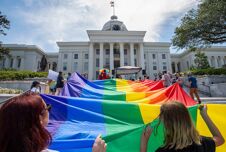In March 2023, conservative activist Billboard Chris – whose full name was Chris Elton – was assaulted by a trans woman at a trans rights rally in Vancouver, Canada.
Video footage shows Elton being approached by the woman while he appeared to be peacefully protesting the rally.
Related:
MSNBC guest skewers Kyrsten Sinema as type of white person “Martin Luther King Jr. warned us about”
“These are the white liberals who have no sense of urgency, commitment or integrity when it comes to the progress of justice in the country,” said Elie Mystal.
After a while, the trans woman began to shout profanities at Elton, who maintained composure throughout the verbal attacks.
Dive deeper every day
Join our newsletter for thought-provoking commentary that goes beyond the surface of LGBTQ+ issues
The profanities increased in intensity until the woman was in his face. She then proceeded to shove Elton and drag him by his clothes. Police rushed in to de-escalate the situation.
Elton claimed the police didn’t do anything, which was evidently false, and that all the blame belonged to the woman who attacked him. However, the officers who were there stated both parties were at fault.
It’s understandable why marginalized communities would sometimes resort to violence, but responses like these are often used against us to both undermine our suffering and dismiss our pleas for change.
In short, any violence we inflict on conservatives only stokes the burning rage they have for us, resulting in even more passionate (and violent) attempts to strip us of our rights.
It’s a new year, which means we can expect new and more creative ways for anti-LGBTQ+ pundits and activists to come for the rights of LGBTQ+ folks.
In Florida this week, Republicans introduced a bill seeking to make the act of “lewd or lascivious grooming” a second-degree felony, punishable by up to 15 years in prison. The bill is a thinly veiled attempt to make LGBTQ+ content a felony, as “groomer” has become a viscious slur used by the right to refer to LGBTQ+ people.
In Ohio, a slate of regulations proposed the first week of 2024 could force even trans adults in the state to detransition.
As trans people and advocates fight back against draconian laws like these, we have indeed witnessed multiple wins.
Last June, Arkansas became the first state to see its gender-affirming care ban for trans youth overturned following a ruling from Judge James Moody of the Eastern District of Arkansas.
That same month, Judge Thomas Parker of the Western District of Tennessee fully repealed S.B. 3, declaring the state’s drag ban unconstitutional.
While our methods to secure equal rights for LGBTQ+ folks — which consist of both peaceful and chaotic protests to defeat bills that stifle us — have resulted in some success, there is always room to think about how the movement can do better — especially as our opponents constantly hone their own tactics.
Today we honor Martin Luther King, Jr., whose philosophy of nonviolent resistance is one any movement could look to for guidance.
Nonviolent protest is a form of resistance that seeks to create social change by means of civil disobedience or political noncooperation while refraining from violence of any kind.
King’s philosophy of nonviolence was inspired by the teachings of Gandhi, who emphasized the importance of love and nonviolence. He saw Gandhi’s teachings as the ideal method for achieving social reform, and he made use of them during the Montgomery bus boycott in 1955. He led the boycott with unarmed bodyguards despite threats on his life, and he reacted to the bombing of his home with compassion.
“Don’t get panicky. Don’t do anything panicky at all,” he told his supporters. “Don’t get your weapons. He who lives by the sword shall die by the sword. Remember that is what God said. We are not advocating violence. We want to love our enemies. I want you to love our enemies. Be good to them, love them and let them know you love them.”
King’s philosophy of nonviolence had six principles, which he elucidated in his book, Stride Toward Freedom.
First, one can resist evil without resorting to violence.
Second, nonviolence seeks to win the “friendship and understanding” of the opponent, not to humiliate him.
Third, evil itself, not the people committing evil acts, should be opposed.
Fourth, those committed to nonviolence must be willing to suffer without retaliation as suffering itself can be redemptive.
Fifth, nonviolent resistance avoids “external physical violence” and “internal violence of spirit” as well: “The nonviolent resister not only refuses to shoot his opponent but he also refuses to hate him,” King wrote. The resister should be motivated by love in the sense of the Greek word agape, which means “understanding,” or “redeeming good will for all men.”
Sixth, the nonviolent resister must have a “deep faith in the future,” stemming from the conviction that “the universe is on the side of justice.”
King believed that “darkness cannot drive out darkness: only light can do that. Hate cannot drive out hate: only love can do that. The beauty of nonviolence is that in its own way and in its own time it seeks to break the chain reaction of evil.”
King’s way of thinking also has data to back it up. Research suggests that nonviolent protests are ten times more successful than violent ones. In her book, Why Civil Resistance Works: The Strategic Logic of Nonviolent Conflict, Harvard Professor Erica Chenoweth explains how civil resistance campaigns garner more support.
Chenoweth explains, “Nonviolent campaigns are on average four times larger than the average violent campaign, and are often more representative in terms of gender, age, race, political party, class, and the urban/rural distinction. Civil resistance allows people of all different levels of physical abilities to participate. Everyone is born with the ability to resist nonviolently. Violent resistance is a little more demanding and therefore more exclusive.”
While nonviolence appears to be more effective, there are still several disadvantages to this form of protest.
First of all, peaceful protests may not receive as much attention from the media or decision-makers as more disruptive or violent protests, thus making it harder for protesters to gain the recognition they need to achieve their goals.
Additionally, some peaceful protests can provoke violence from the opposition and become quite dangerous for those involved.
Peaceful protests may also not be enough to achieve the desired change. This could be due to a range of factors, such as lack of political will, entrenched systems of power, or the complexity of the issue at hand.
They are also only effective if the people in power have a conscience.
Lastly, similar to violent protests, peaceful protests may disrupt the daily lives of those who live or work in the area where the protest is taking place. This could lead to frustration or anger among those who are inconvenienced, which could undermine support for the protesters’ cause.
Sometimes, it makes sense for the marginalized and disenfranchised to be driven to violence in their attempts to make change, but in the end, more violence will be required to maintain the newfound influence.
In the end, the most salient reason to choose nonviolence is that violence can scare away current and potential allies.
Furthermore, the biases conservatives had may be vindicated by the presence of violence at these protests, resulting in them feeling more emboldened to attack those who are different from them, leaving no room for potential understanding and acceptance.
In spite of the disadvantages of nonviolent protests, it makes more sense to choose the route of nonviolence. Peace fosters conversation, which fosters empathy, which lends support. And the more support we have, the louder our collective voice becomes. The louder that voice becomes, the harder it is for our opponent to ignore us.
In June 2020 a silent march for Black trans lives took place in Brooklyn, New York. Approximately 15,000 people attended, and the New York Times described it as “one of the most striking demonstrations that New York has seen since the killing of [George] Floyd, a gathering of thousands of people in a sea of white. Its size and intensity stunned bystanders, participants and the organizers themselves.”
Organizer Eliel Cruz said the march showed that “the violence that’s affecting Black trans women and Black trans folks is finally getting the attention that it deserves.”
And activist Raquel Willis, who spoke at the rally, said the organizers’ success at planning the march represented a “new, grander version” of the power of the queer community.
“It felt like we had arrived in a new era,” she said.
The march is a prime example of the power of peaceful protests and the immense impact they can generate. King knew this, and now we must follow in his footsteps.
















Martin Luther King Jr. shows us how to harness the immense power of the queer community